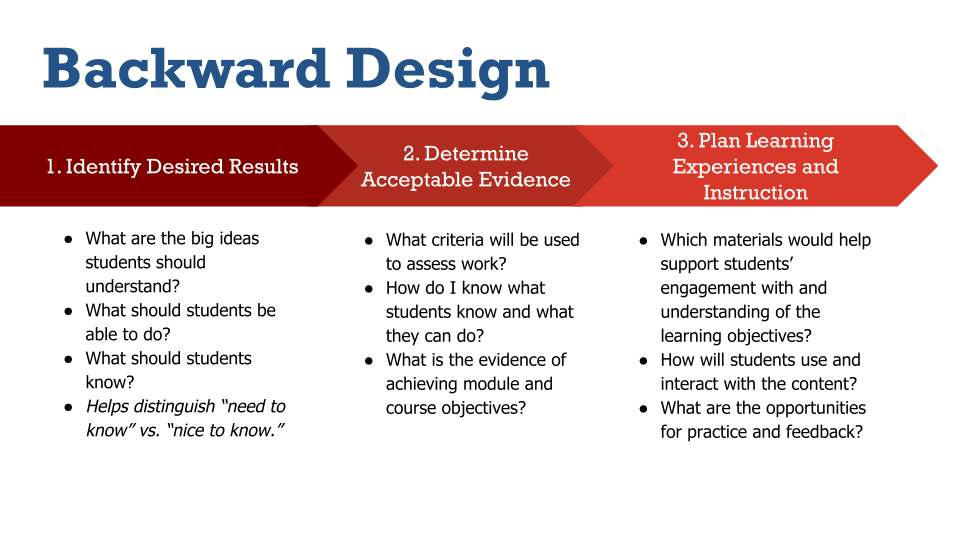Would you like to make sure that you are searching for instructional materials in the most efficient way? Do you want to ensure that the materials you select will have the greatest impact on your established curriculum and on student learning? Using a well-established instructional design process can assist in your search and integration journey. Let's take a look at one such process called Backward Design, developed by Wiggins and McTighe (1998), which states that you should start with the end in mind—that is, what you want students to know or be able to think, feel, or do by the end of the course.
"Our lessons, units, and courses should be [constructed] from the results sought, not derived from the methods, books, and activities with which we are most comfortable" (Wiggins & McTighe, 2005, p.14).
The Backward Design method is broken into three stages:

Vanderbilt's Center for Teaching states that the Backward Design method is beneficial to teachers because "It continually encourages the instructor to establish the purpose of doing something before implementing it into the curriculum," and if done thoroughly, it removes extraneous activities and tasks that were added for the sake of doing them—as is the case with activity-focused or just-for-coverage types of instruction. Similarly, this can help highlight areas of strength in the curriculum, where additional materials may not be needed. If the process is followed, "every task and piece of instruction has a purpose that fits in with the overarching goals and goals of the course."
The backward design method was talked about in podcast and blog formats on Cult of Pedagogy, where the author/speaker reflected on her journey through the process and shared examples of what a middle school science lesson looked like before and after. As shown in the video from Edutopia below, using backward design can shift teachers away from simply "covering" material to injecting authentic, meaningful learning that deepens their understanding of the content.
According to The Online Course Mapping Guide, "a course map is a visual overview of all components of an online course. Course maps organize the structure of a course around its learning modules. Each module is broken down into its components: module outcomes, assessments, activities, instruction, and then linked or mapped to the corresponding course learning outcome to show alignment."
Creating a complete course map can take a significant amount of time, and as such, it is not necessarily being recommended for the purposes of this class. We mention it here as one of the ways in which you can visualize the backward design process and find and integrate open educational resources with a systematic approach.
For more information on creating a course map with the purposes of building strong alignment between learning objectives, assessment, activities, and materials, see:

To better understand how backward design or other frameworks can help you make the most of your curriculum and search and integration process, consider taking INFOhio's High-Quality Instructional Materials to Supplement Your Curriculum class, available at no cost and for 5 contact hours upon completion.
Fetch is avaiable to INFOhio automated schools. If you are an INFOhio school, please log in with your school username/password using the button at the top-left corner of this page.
For more information about Fetch, please visit the Fetch information page or contact INFOhio support at https://support.infohio.org.